It was coming – another winter storm traveling east across the country bringing frigid temperatures, snow, ice, and sleet to the Carolinas. The meteorological media now names these storms, this one Cora. The Upstate and Midlands received snow, the inland Lowcountry a brief mix, and the coast merely a cold rain. But our neighborhood received another white wave on a gray day – a squadron of white pelicans populating the Intracoastal Waterway (ICW). (Yes, large groups of white pelicans swimming together are often called squadrons).
The arrival of these large white migrants has been one of many highlights of wildlife in Cape Romain National Wildlife Refuge. These are spectacular birds, one of the largest in North America. The mature adults weigh up to sixteen pounds, with a wingspan up to nine feet. The beaks are long and salmon or orange-colored; the feet and legs are orange. Unlike their cousins the brown pelicans, they do not plunge dive but fish by dabbling, dipping their beaks beneath the surface. In flight the black wing tips show. An unmistakable identification – magnificent.
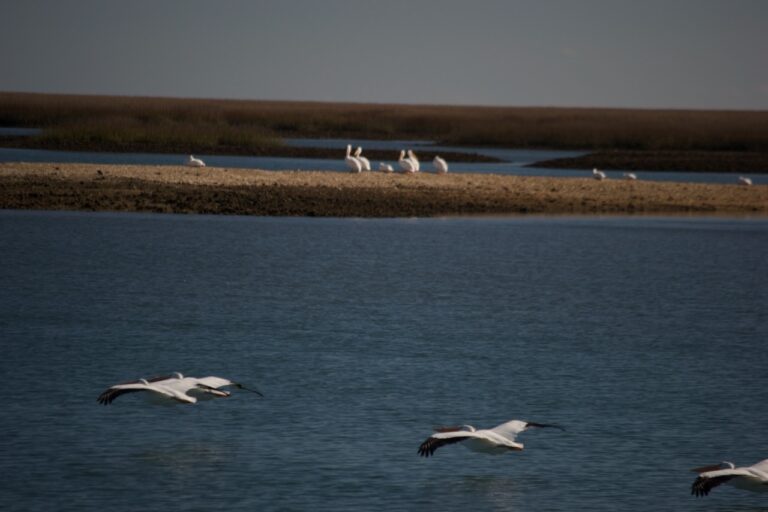
My first view of them was on that Friday when the winter storm arrived. The next day, having walked to the landing, I rode home and returned with camera to catch some of the action: birds roosting on the middle shell bank, swimming across the waterway, and gathering together in tight pods around neighbors’ docks. It was a gray and cold day: I viewed from the landing, and went to a neighbor’s dock for more observing and photos.
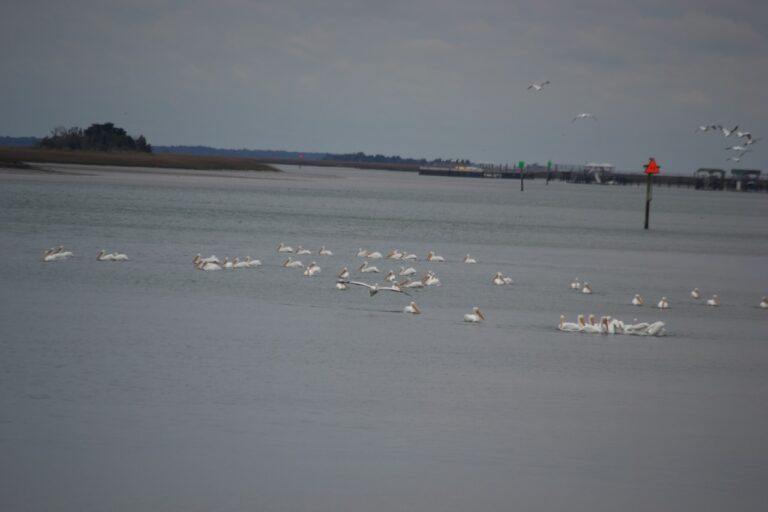
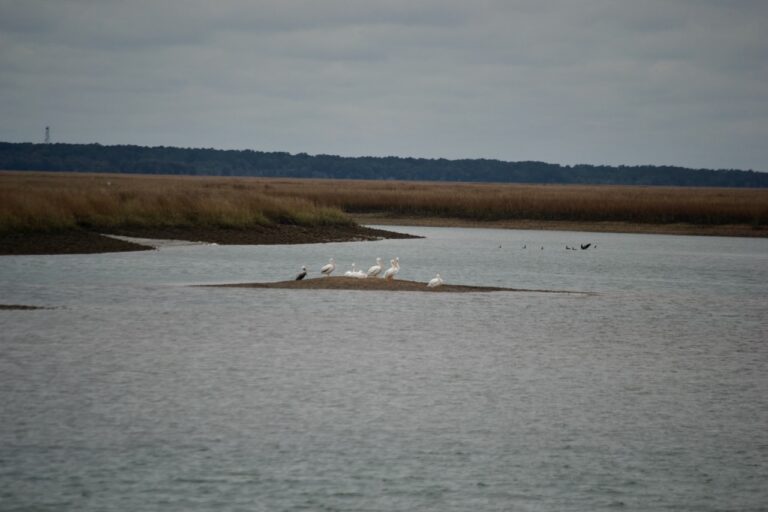
I would return the following days for more observing, and they continued their residence in the ICW next to our neighborhood. On Sunday I rode my bike to the landing loaded up with binoculars and camera. The weather had cleared, and the sun and blue sky created a fine background for these huge white birds. A few birds roosted on the middle shell bank across from the landing, but the majority of the birds were in the water a mile to the south. The flock soon got up and flew north, passing by my location and displaying their flight prowess, though not of their soaring ability. These birds sure can fly – what a journey to migrate here. The short flights viewed do not suggest their ability to soar at great heights over long distances.
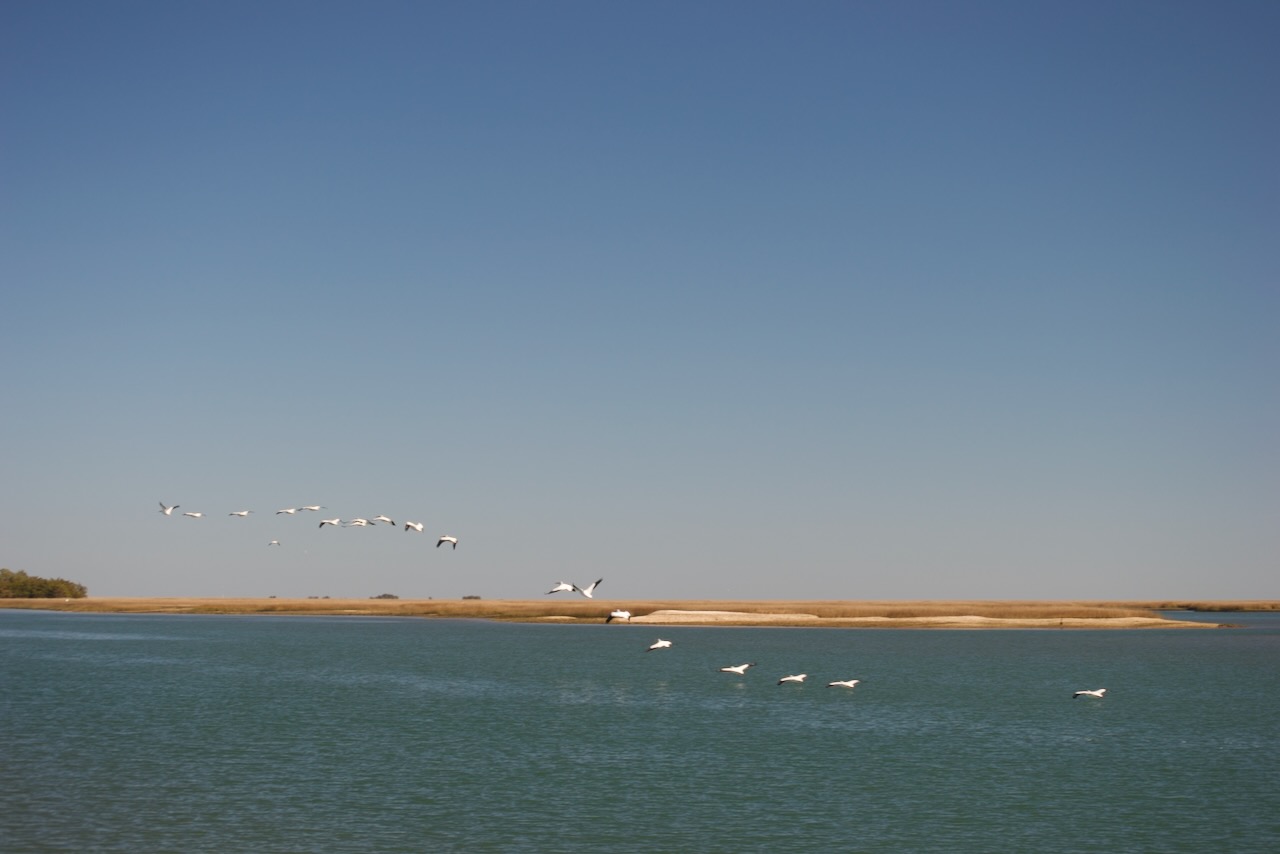
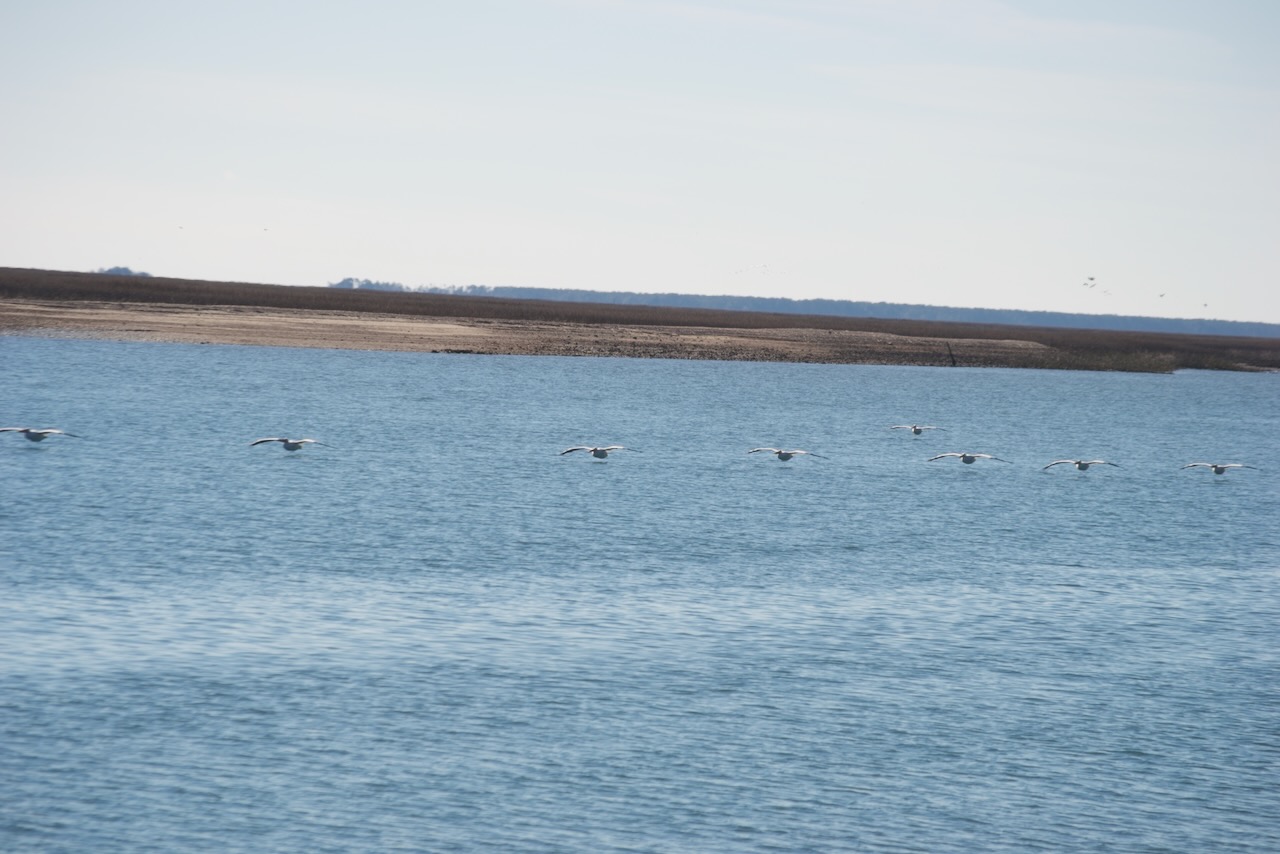
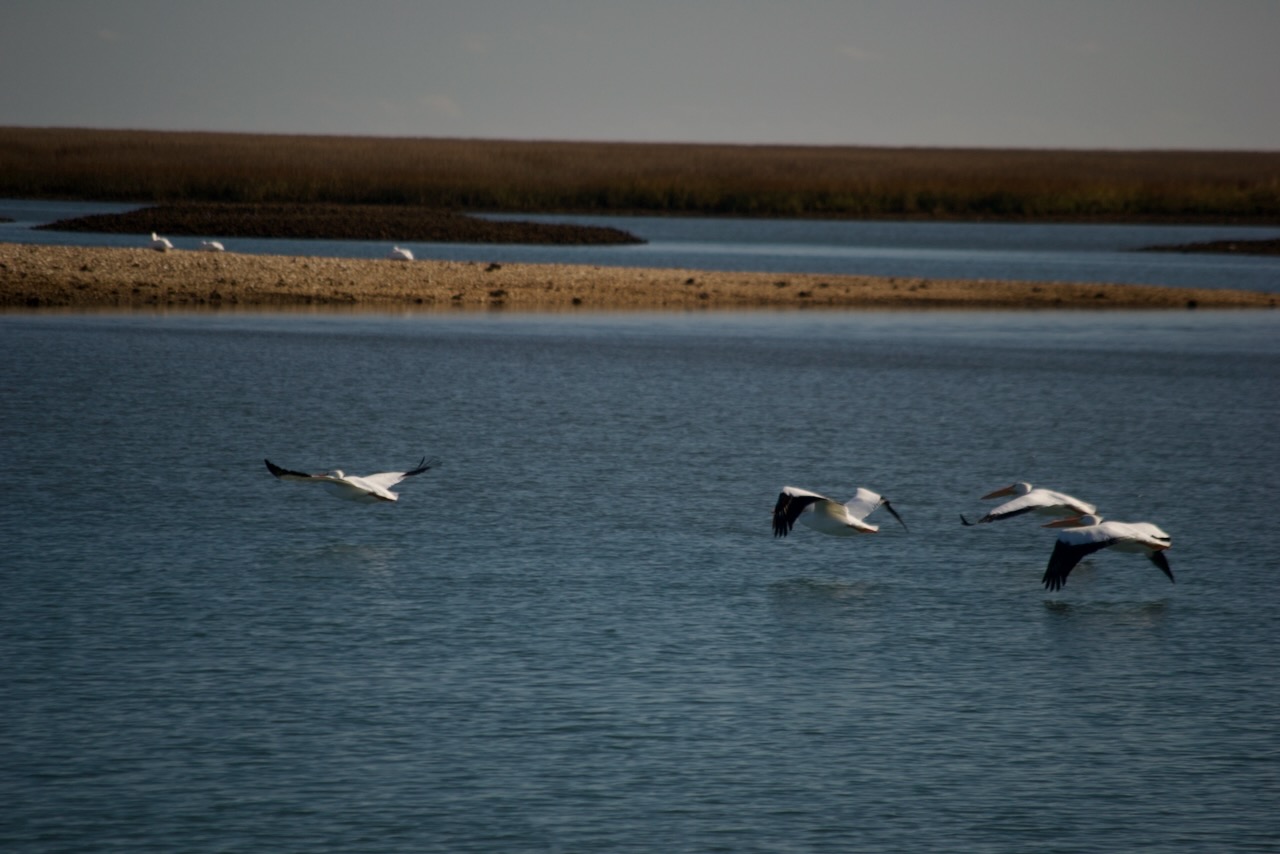
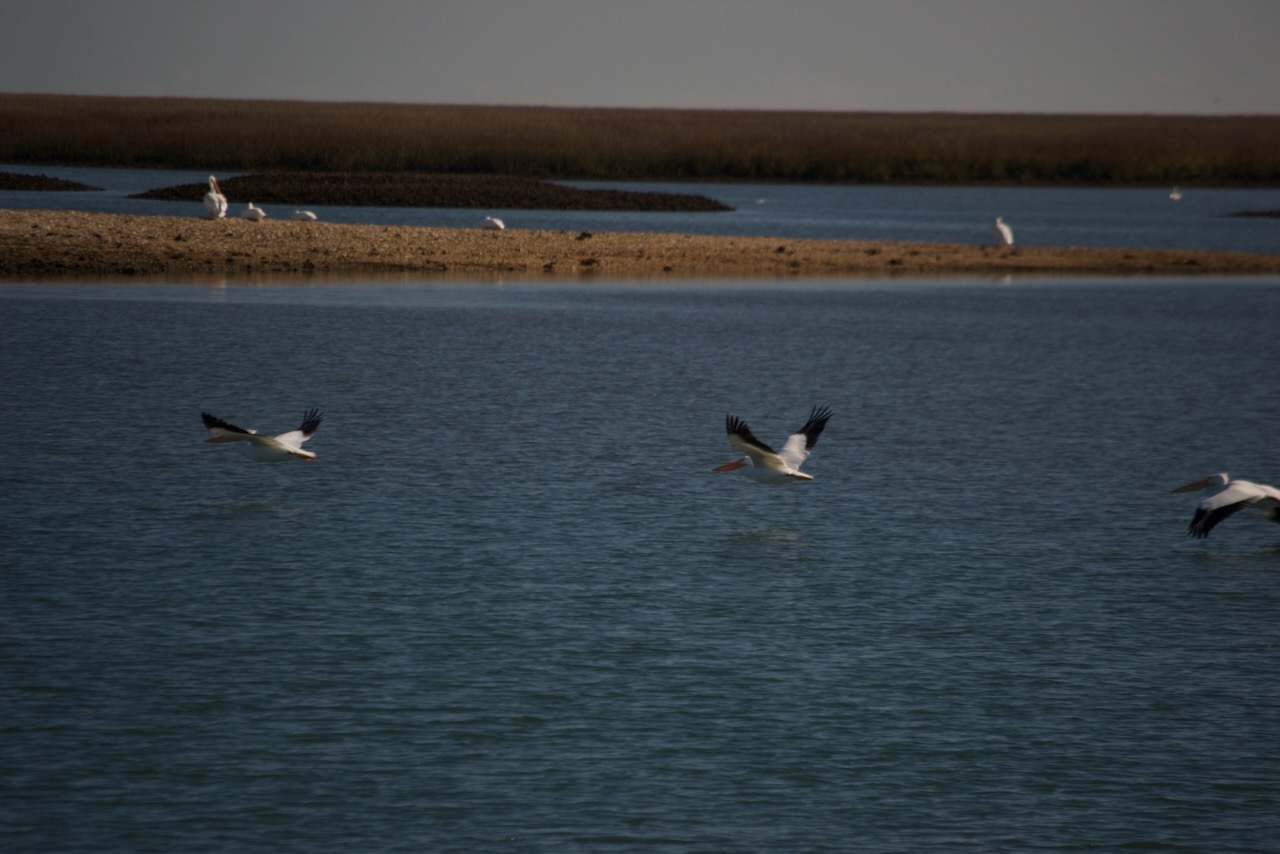
They landed and gathered to the north in shallow water on the refuge side of the ICW into a squadron, perhaps a half-mile from the landing. I watched with binoculars as a flurry of activity commenced. The pelicans were gathered in a tight knot, and frequently birds flew up and landed in a different spot in the clump. Meanwhile splashes of large bodies occurred outside the pelican circle – dolphins. Did the pelicans locate the fish by the dolphin feeding event? Or was this interspecies cooperation to herd the fish in shallow water for a feast?
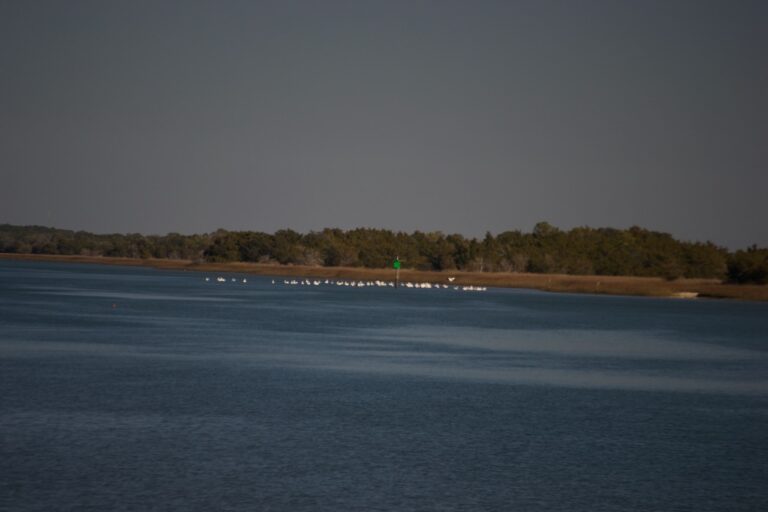
Calling my friend Brantley who lives along the water in that direction, I alerted him to the event and rode my bike to his home. The pelicans were located further to the north, and we rode up to a neighbor’s property and walked out on the dock directly across from the pelican gathering. Unfortunately, the feeding event was over, and the pelicans gracefully swam away. Lined up across the ICW, they faced off with a “snowbird” heading south. They moved out of the channel as the boat cruised by. Small groups dispersed as pods, some swimming and some taking flight.
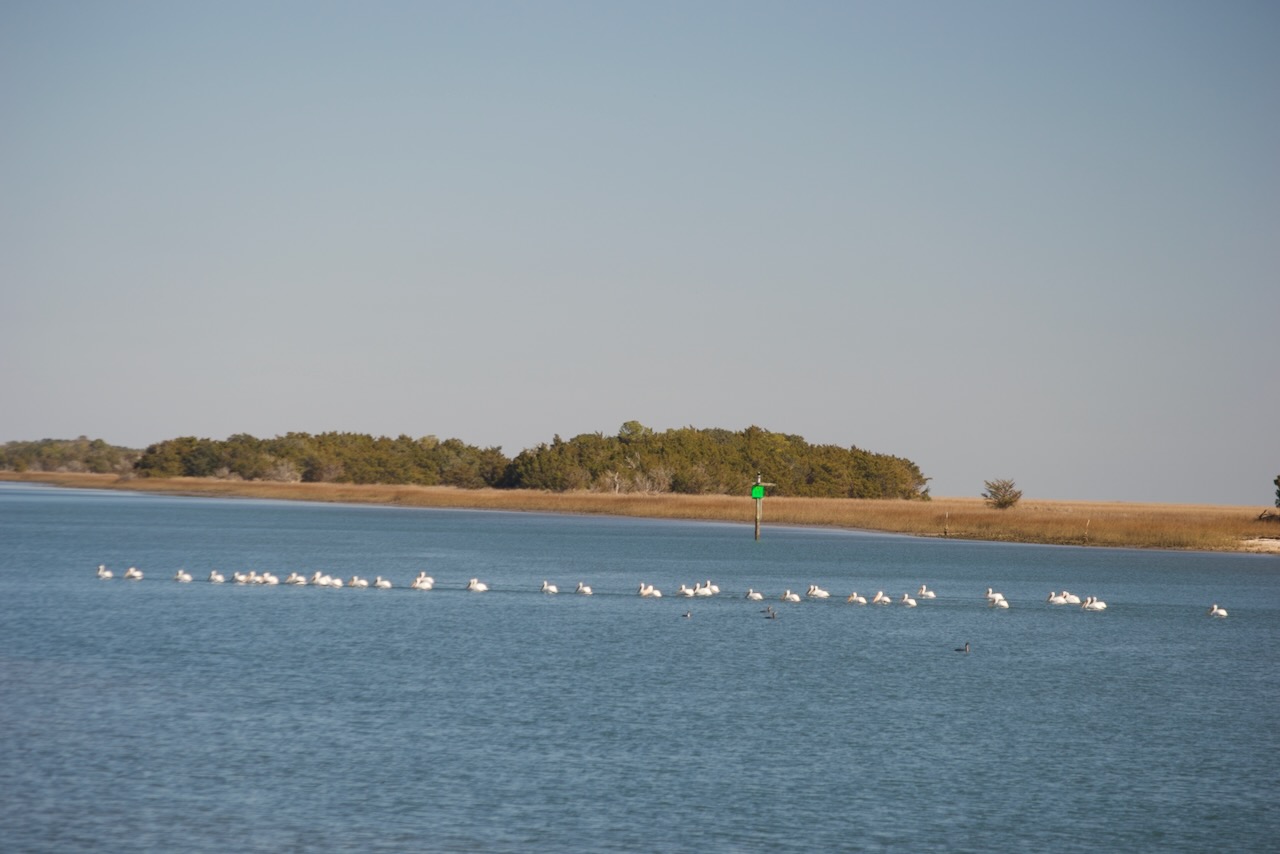
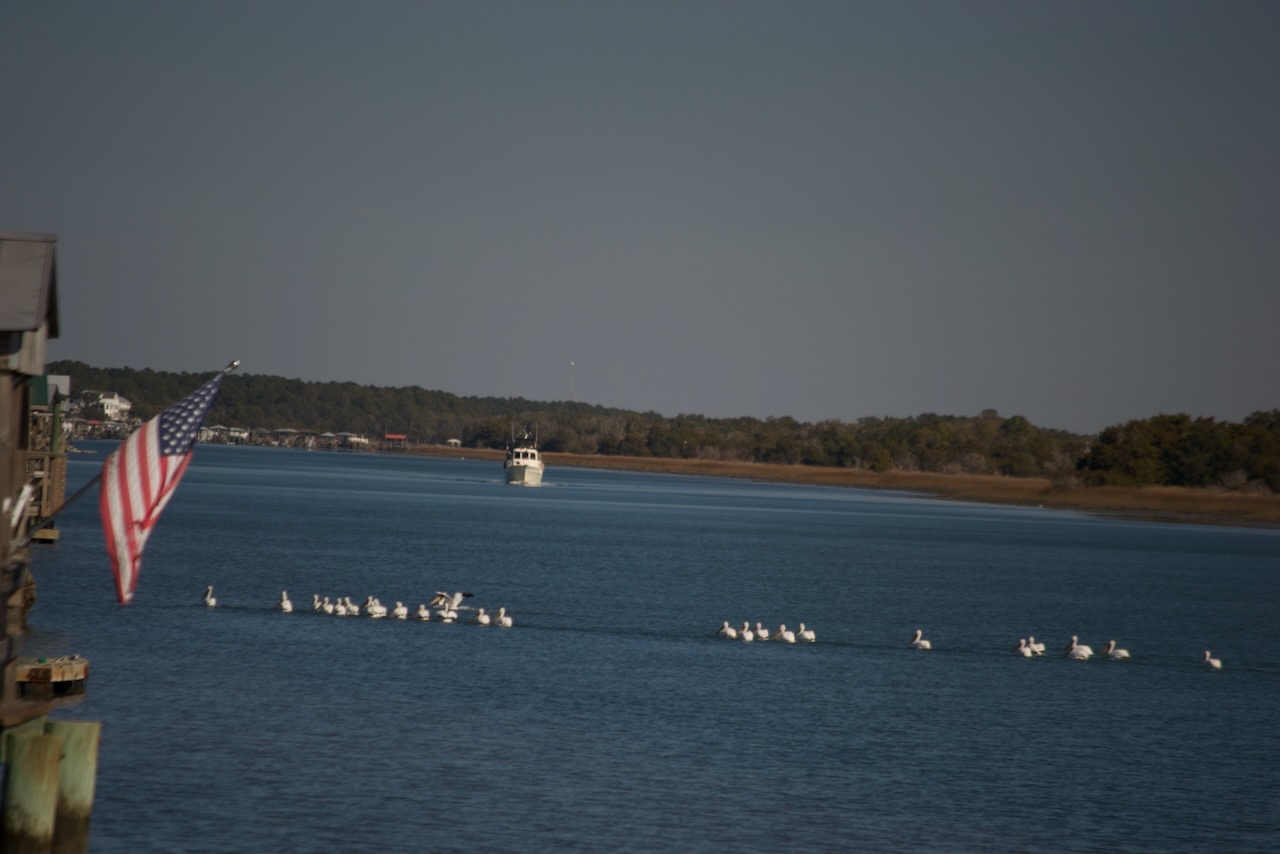
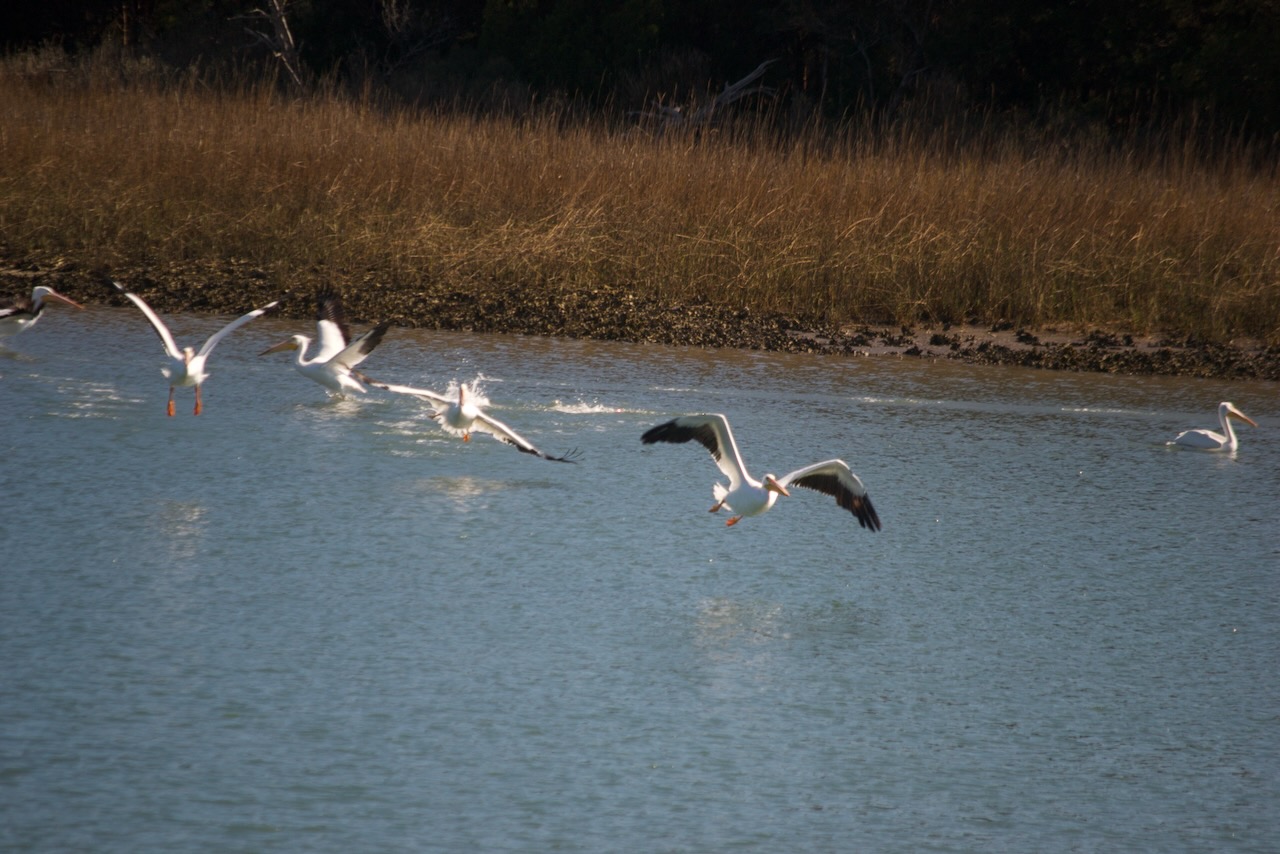
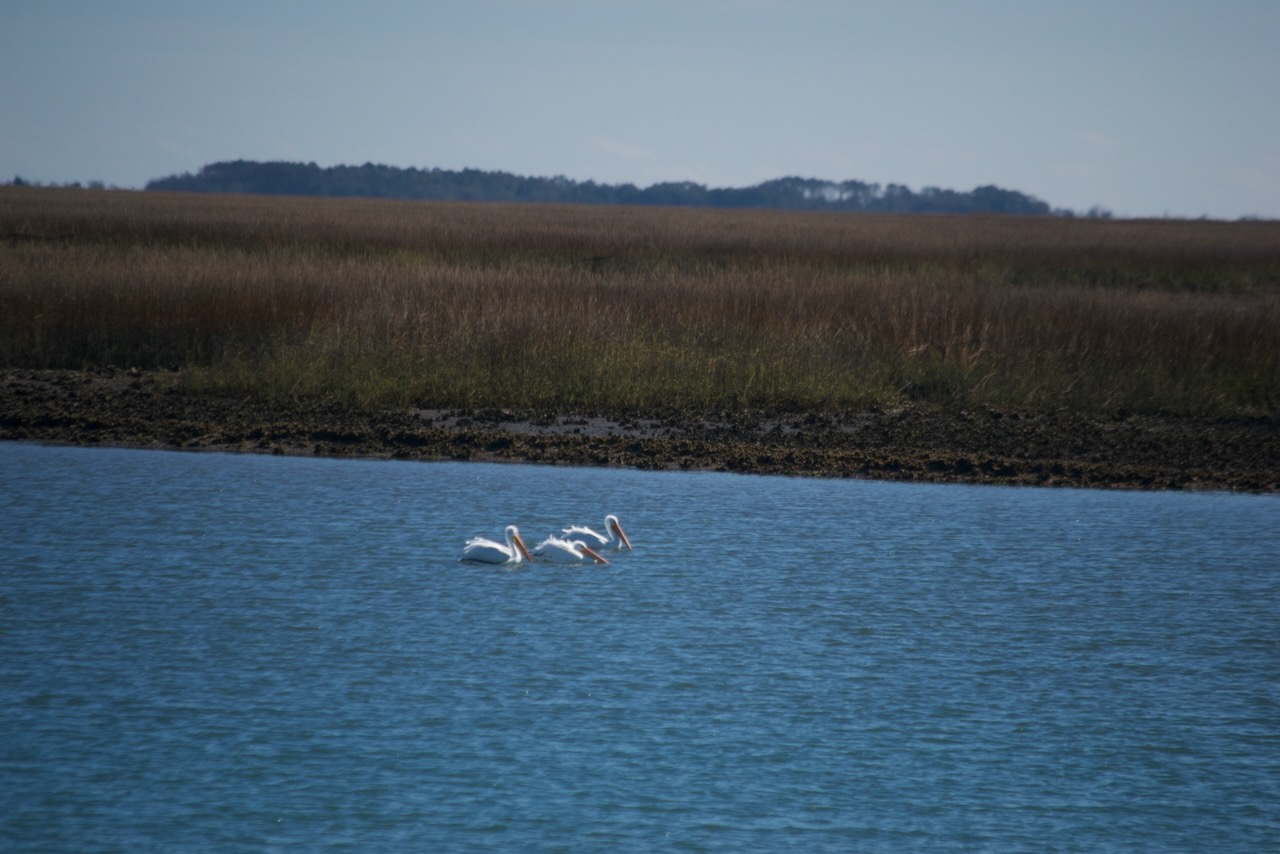
The pelicans continued their residence near the landing in the coming days, and I maintained my vigil. One day a small group was directly across from the landing, and as several dolphins swam by, one pushed a fish out of the water, triggering the pelicans to take flight and land in the area. Though no feeding event occurred, I wondered again if pelicans used dolphin feeding as a means to find and corral fish.
On Wednesday I traveled to the landing to do my monthly water monitoring as part of South Carolina’s Adopt a Stream program. I was greeted with a line of white pelicans swimming in a line past the landing perhaps ten yards off the dock. It was a major distraction for the tasks I would complete and record. The squadron began to feed along the docks to the north. Working from the pier head, I was moving to the floating dock for other measures when a closely packed group was returning in my direction. They eventually turned to head back north.
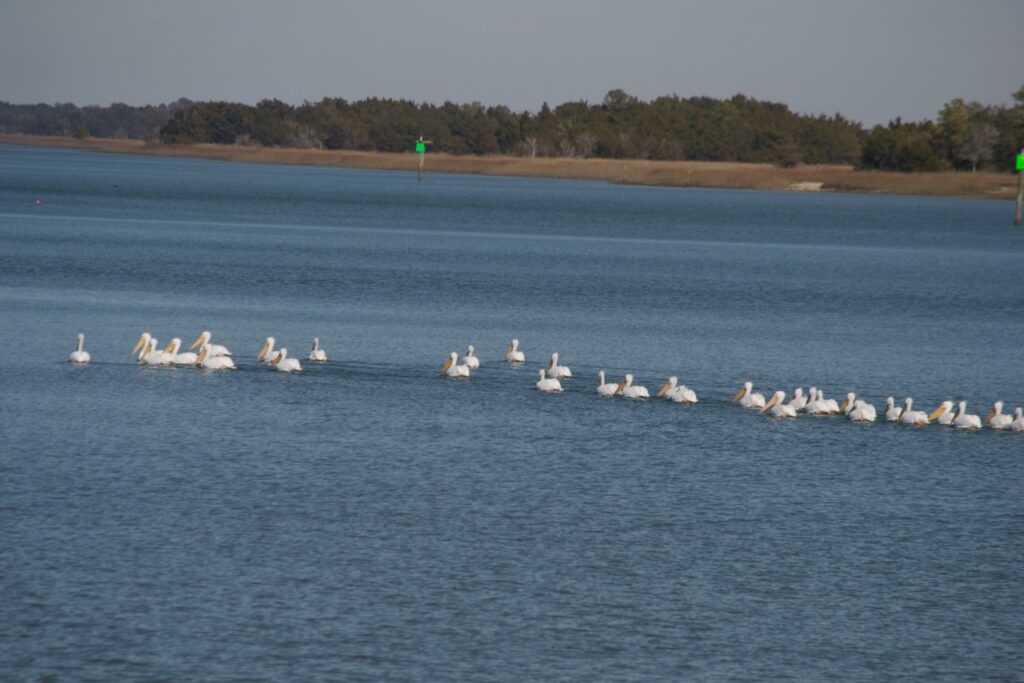
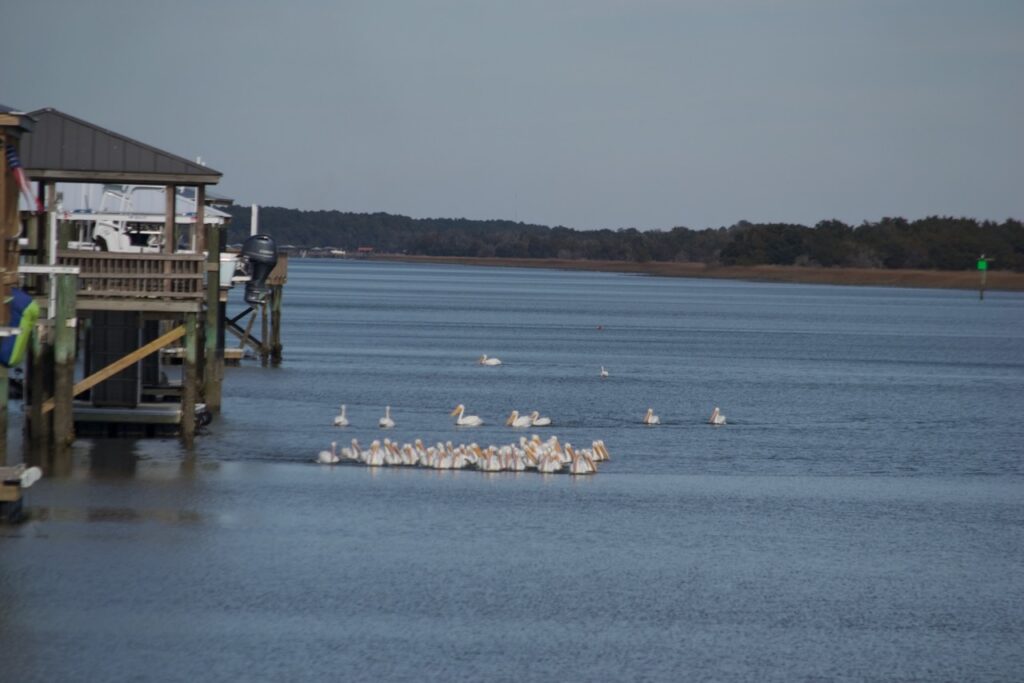
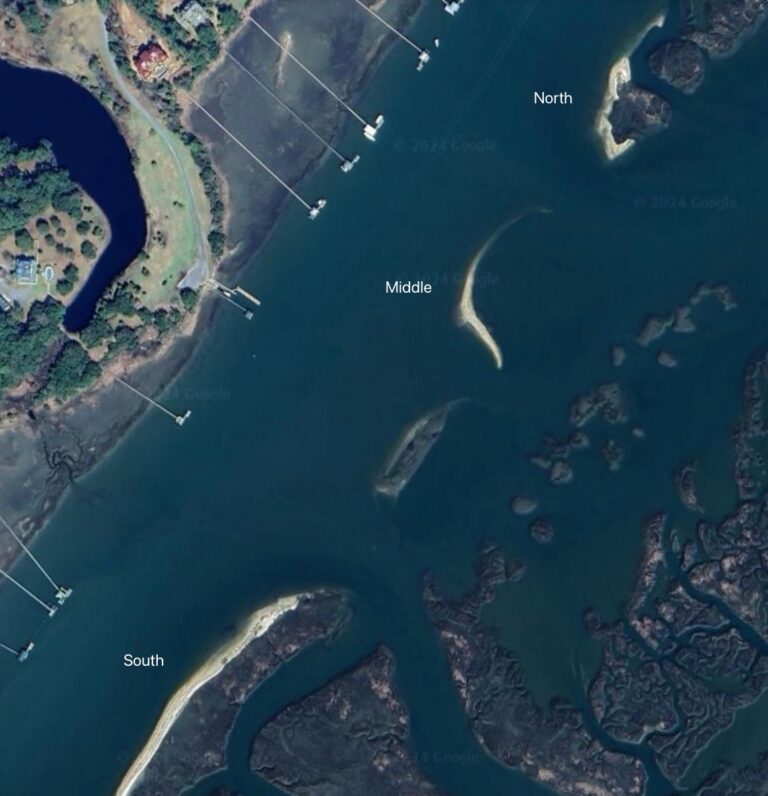
The next day I walked to the landing a little after sunrise for exercise and to see what was happening. A cold clear morning, quite promising, and I was not disappointed. White pelicans were scattered to the north in the waterway, gulls and oystercatchers stood on the middle bank, and the flock of oystercatchers was on the high tide roost on the southern shell bank. A snowbird catamaran was motoring south on the ICW, and twice the pelicans took flight and landed ahead, finally near the middle bank. The birds swam toward the bank, the gulls departed, and the pelicans slowly began the occupation of the exposed shoal. The oystercatchers took off and joined the flock on the southern shell bank. The middle bank filled up with the pelicans, over forty, crowding onto the slowly flooding shells. Another flight of oystercatchers passed behind the shoal heading to the southern shell bank; another group came up from the south and also landed there. So much going on in the bird world on this wonderful morning.
I don’t know when the white pelicans arrived in Cape Romain this year, only when I first observed them. The place of departure for their migration was also a mystery. From what I gathered the population that breeds east of the Rocky Mountains migrates south and east along river valleys to the Gulf Coast and Florida. Yet here they were, an annual winter residence. I don’t know when they will depart; I will keep watch.
🙂 It pays to be alert for winter guests ! We have a winter guest(s) at our hummingbird feeders. See birds in the morning after it warms up a bit and then in the afternoon/evening. Have 3 feeders out and have seen birds at each so don’t know if it is 1 or several. In any case I’ve seen only females.
Hummingbirds at your feeders! I have seen people having painted buntings at their feeders in various places this winter. Winter guests indeed.
Beautiful pictures! Sounds like you may get to see some snow coming up this week!
Looks like we may also see some serious winter weather.
Great to see and read about the White Pelicans. Thank you for being so vigilant.
They’re very beautiful.
I guess we need to put our hummingbird feeder back up and some millet out!
Thanks for sharing👍❤️
Continuing the vigil. None sighted yesterday x3. This morning a squadron of about fifty was cooperatively fishing around ICW marker #65.
Absolutely loved the photographs and colorful commentary about the beautiful white pelicans! I appreciated all of your efforts to follow them! I can picture you speeding on your bike, binoculars around your neck, to keep up!
Thank you! Angie
Thanks for the comment, Angie. I admit I have been following the white pelicans, the oystercatchers, and everything else out there from shore.